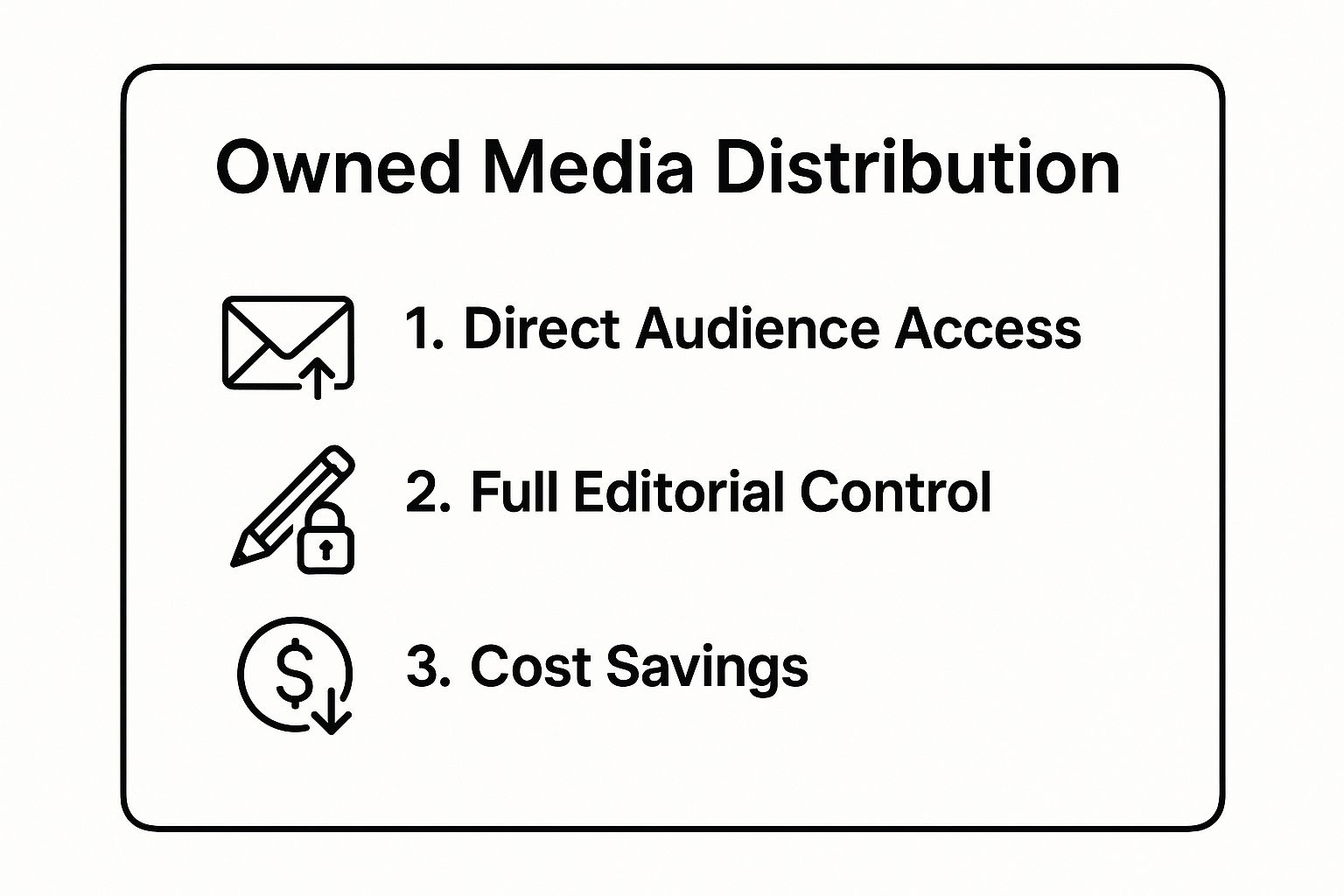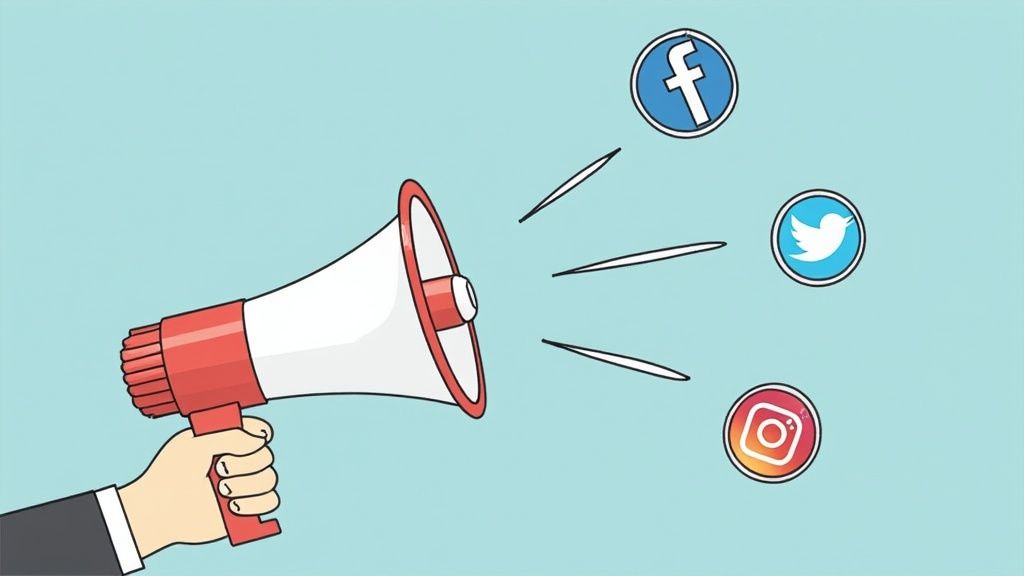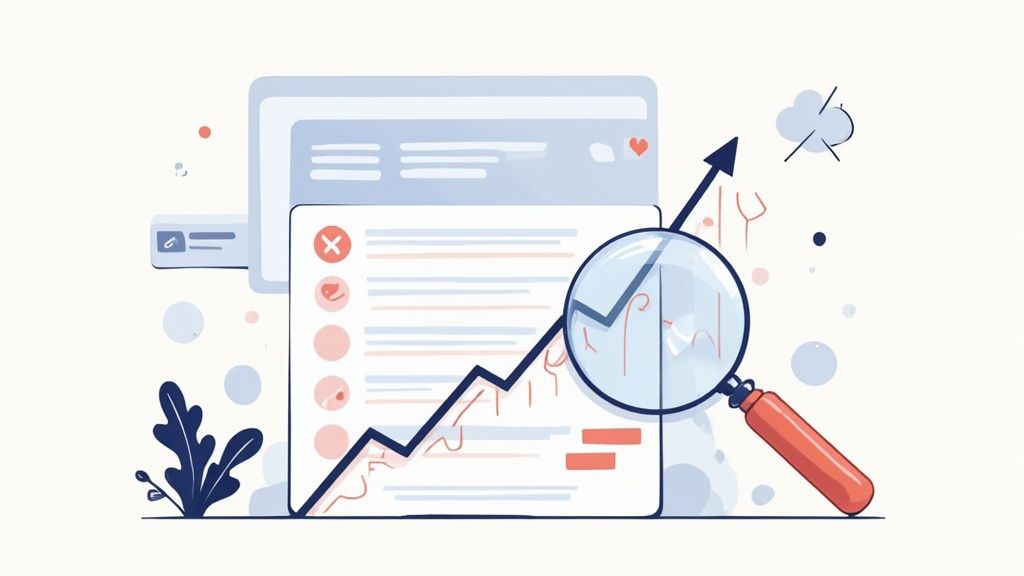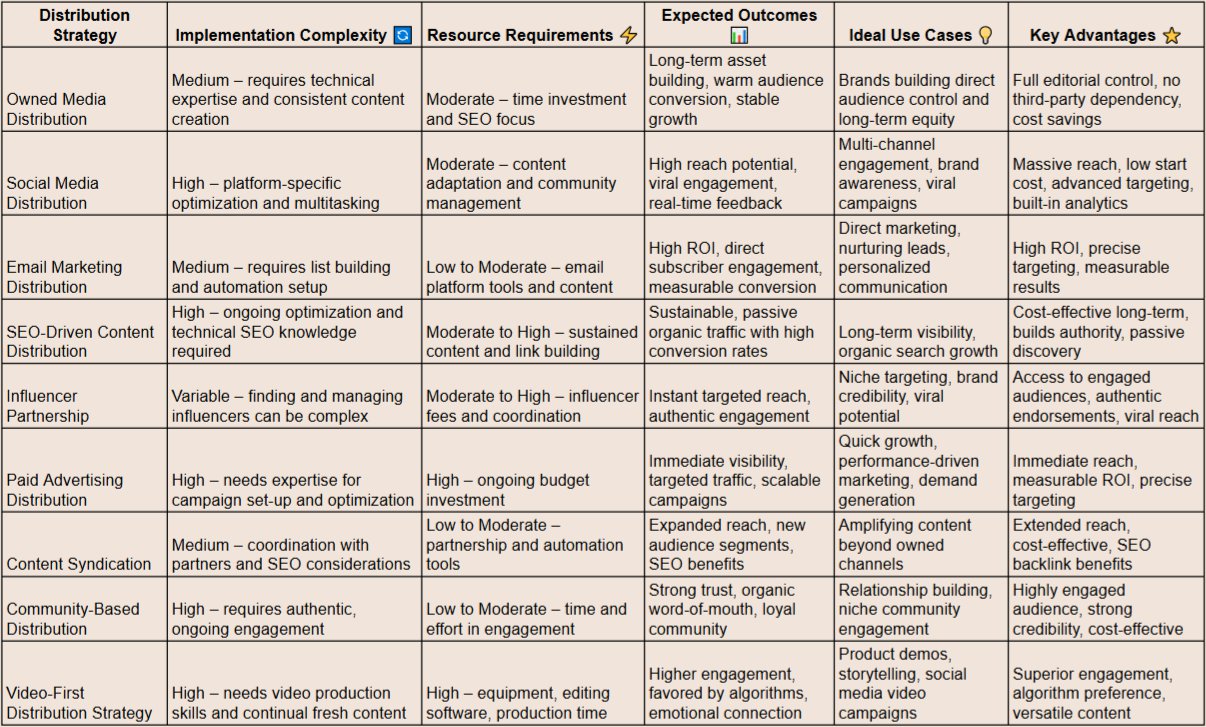Creating exceptional B2B content is only half the battle. Without a robust distribution plan, even the most insightful podcast episode, whitepaper, or blog post will fail to generate pipeline or build authority. The challenge isn't a lack of effort in creation, but a critical gap in amplification. Many B2B marketing teams focus 90% of their resources on producing content and only 10% on getting it seen, when the ratio should be closer to 50/50. This imbalance leaves valuable assets underutilized and ROI unrealized.
This guide provides a definitive list of battle-tested content distribution strategies designed specifically for B2B brands. We move beyond generic advice to provide actionable frameworks you can implement today. You will learn how to effectively leverage owned media, social channels, email, SEO, and strategic partnerships to ensure your content reaches the right audience, on the right channels, at the right time. Let's explore the nine essential strategies that transform your content from a static asset into a dynamic engine for growth. This is how you ensure every piece of content you create delivers maximum impact and measurable results for your business.
1. Master Your Owned Media Channels
The foundation of any robust content distribution strategy is leveraging the channels you directly control. Owned media includes your website, blog, and email list, giving you unparalleled command over your message and a direct line to your most engaged audience. This approach is fundamental for sustainable growth, insulating you from the volatility of third-party platform algorithms.
For B2B podcasters, this means transforming your website into a central hub for your show. Instead of just embedding an audio player, create a comprehensive ecosystem around each episode. This builds a long-term asset that generates organic traffic and nurtures leads. As Tom Hunt, founder of Fame, emphasizes, “your podcast is NOT your marketing strategy, your podcast is a content generation machine for your marketing strategy.” Building a strong owned media presence around it is crucial for establishing authority.
Actionable Implementation Steps
- Create SEO-Optimized Episode Pages: Don't just post a player. Build dedicated pages for each episode with full transcripts, detailed show notes, guest bios, and links to all mentioned resources. This turns your audio content into a searchable, indexable asset for Google.
- Develop Lead Magnets from Your Content: Repurpose your podcast's key insights into valuable downloads like checklists, templates, or executive summaries. Offer these in exchange for an email address to actively grow your subscriber list.
- Establish a Dedicated Newsletter: Your email list is your most valuable distribution channel. A well-crafted B2B newsletter can announce new episodes, share exclusive behind-the-scenes content, and provide value beyond the podcast. Fame helps ambitious B2B companies with its specialized B2B Email Newsletter Agency.
- Promote and Interlink: Feature your latest episodes prominently on your homepage and within relevant blog posts. Internal linking between your articles and podcast pages signals content hierarchy to search engines and keeps users engaged on your site longer.
The summary box below highlights the core benefits of prioritizing your owned channels for content distribution.

These three pillars demonstrate why owned media is the most reliable and cost-effective foundation for your content distribution strategies. By controlling the platform and the audience relationship, you build a resilient marketing engine that pays dividends over time.
2. Social Media Distribution
A multi-platform social media presence is essential for modern content distribution strategies. This approach involves more than just sharing links; it means adapting and natively publishing content for each platform’s unique algorithm, format, and user behavior. By doing this, you can significantly amplify reach, foster community, and drive traffic back to your core owned media assets.

For B2B podcasting, this means treating platforms like LinkedIn and X (formerly Twitter) as distinct channels with unique opportunities. The goal is to meet your audience where they are with content that feels native to their feed. This strategy revolves around creating micro-content from a single long-form piece, maximizing the value of every episode you produce. It turns your podcast into a content engine that fuels a consistent, multi-channel social presence, which a B2B Social Media Agency like Fame can manage for you.
Actionable Implementation Steps
- Create Platform-Specific Micro-Content: Pull short, impactful audio or video clips from your podcast. For LinkedIn, create a professional video clip with a text overlay highlighting a key business insight. For X, use a compelling quote graphic or a short audiogram to spark conversation.
- Tailor Your Captions and Tone: Your LinkedIn post should be professional and analytical, while your post on X can be more conversational. Adapt your messaging to match the platform's user expectations to increase engagement.
- Use Native Features to Your Advantage: Leverage LinkedIn articles to post episode transcripts or summaries. Use X polls to engage your audience on episode topics and Instagram Stories to share behind-the-scenes clips.
- Engage Authentically with Your Community: Social distribution is a two-way street. Respond to comments, participate in relevant conversations using industry hashtags, and engage with your guests' and listeners' content to build a loyal community.
The video below offers a deeper look into creating a social media strategy that delivers tangible results and builds brand authority.
By systematically repurposing your core podcast content for social channels, you create multiple touchpoints for your audience. This not only increases the visibility of each episode but also reinforces your brand’s authority across the digital landscape, making it a critical component of any B2B content marketing plan.
3. Email Marketing Distribution
While owned media provides a foundation and paid media expands reach, email marketing offers a direct, personal channel to deliver content straight to your most loyal followers. It's one of the most powerful content distribution strategies because it leverages a permission-based relationship, ensuring your message reaches an audience that has explicitly opted in. This direct line of communication is invaluable for nurturing leads and fostering long-term engagement.
For B2B brands, email isn't just for promotion; it's a vehicle for delivering consistent value. Newsletters like those created by Morning Brew or TheSkimm demonstrate how a well-crafted email can become a daily habit for subscribers. By adopting a similar mindset, B2B marketers can transform their email list from a simple notification tool into a primary content consumption channel that drives traffic back to core assets like a podcast or blog.
Actionable Implementation Steps
- Create Compelling Lead Magnets: Grow your email list by offering high-value content in exchange for an email address. Repurpose podcast insights into exclusive checklists, templates, or executive summaries that solve a specific problem for your target audience.
- Segment Your Audience: Don't send a generic blast to everyone. Segment your list based on interests, firmographics, or engagement level to deliver more targeted and relevant content. This significantly boosts open rates, click-through rates, and overall engagement.
- Provide Consistent, Non-Promotional Value: Your newsletter should be a destination, not just an advertisement. Share curated industry news, exclusive tips, and behind-the-scenes content that enriches the subscriber's experience beyond simply announcing a new podcast episode.
- Automate Welcome and Nurturing Sequences: Use automation to create a welcome series for new subscribers, introducing them to your best content. Nurture leads over time with sequences that are triggered by their behavior, guiding them through the buyer's journey. Learn more about how to build a powerful B2B newsletter with an agency.
4. SEO-Driven Content Distribution
A truly sustainable growth engine relies on capturing an audience actively searching for solutions. SEO-driven content distribution is a long-term strategy focused on creating and optimizing content to rank highly in search engine results. This powerful approach shifts the dynamic from pushing your content out to pulling in a highly motivated audience, establishing a consistent flow of organic traffic and qualified leads.

For B2B brands, this means creating content that directly answers your ideal customer's most pressing questions. Pioneers like Brian Dean of Backlinko and companies like Ahrefs have built empires by creating comprehensive resources that dominate search results for high-value terms. This method turns your marketing assets into evergreen lead-generation machines that work for you around the clock, long after their initial publication.
Actionable Implementation Steps
- Build Content Around Topic Clusters: Organize your content strategy around central "pillar" pages that cover a broad topic, supported by "cluster" content that delves into more specific, related subtopics. This structure signals your expertise to search engines and improves internal linking.
- Prioritize Search Intent: Before writing, deeply understand what a user is looking for when they type a keyword. Are they seeking information, comparing products, or ready to buy? Tailor your content format and angle to match that intent precisely.
- Optimize for Snippets and Rich Results: Structure your content to be easily scannable by Google. Use clear headings, bullet points, numbered lists, and Q&A formats to increase your chances of appearing in featured snippets, which can significantly boost your click-through rate.
- Create In-Depth, Comprehensive Resources: Aim to create the best, most thorough resource on the internet for your target keyword. Go deeper than competitors, include unique data or insights, and provide immense value to establish your page as the definitive authority. For B2B podcasters, applying these principles is crucial. Learn more about optimizing your podcast for explosive growth with these SEO best practices.
5. Influencer Partnership Distribution
Collaborating with influential individuals in your niche is one of the most powerful content distribution strategies available. This approach leverages the established audiences and credibility of industry experts, utilizing their reach and trust to amplify your brand's message. A key tactic here is podcast guesting, which allows you to reach a new, relevant audience without having to build a channel from scratch.
For B2B brands, this goes beyond typical consumer product placements. It's about aligning with genuine thought leaders whose expertise validates your own. Think of partnerships with niche podcast hosts, respected industry analysts, or technical experts who command authority. Brands like Adobe have mastered this by collaborating with creative professionals who naturally use and endorse their products, creating an authentic and effective distribution channel.
Actionable Implementation Steps
- Prioritize Authenticity and Alignment: Focus on partners whose audience and values genuinely align with your brand. A smaller, highly engaged audience with a niche expert is often more valuable than a macro-influencer with a broad, disengaged following.
- Become a Guest on Other Podcasts: Identify podcasts your ideal customers listen to and pitch yourself as a guest. This positions you as an expert and introduces your brand to a targeted, primed audience. Services like Fame's Podcast Guesting can help you secure placements on top-tier shows.
- Offer Creative Freedom Within Guidelines: Trust the influencer's expertise in communicating with their audience. Provide clear brand guidelines and key messages, but allow them the creative freedom to deliver the content in their own authentic voice.
- Focus on Micro-Influencers for Niche B2B: In specialized B2B markets, micro-influencers (1k-100k followers) often deliver superior results. They typically have higher engagement rates and a more dedicated, trusting audience, making their recommendations highly impactful. You can learn more about how to leverage influencer marketing for your brand with Fame.
By carefully selecting and nurturing these relationships, you can turn influencer partnerships into a scalable and highly credible component of your content distribution strategies.
6. Paid Advertising Distribution
While organic strategies build a long-term foundation, paid advertising distribution offers a powerful, performance-driven approach to accelerate your reach. This method uses paid channels like LinkedIn Ads, Google Ads, and even podcast-specific networks to place your content directly in front of highly targeted audiences. It's about precision, speed, and generating measurable results, making it one of the most effective content distribution strategies for immediate impact.
For B2B podcasting, paid distribution can amplify your best episodes far beyond your existing followers. Instead of waiting for organic discovery, you can guarantee visibility with key decision-makers in specific industries or companies. This transforms your podcast from a content asset into a direct lead generation tool, a strategy championed by performance marketing experts who emphasize testing and data-driven optimization.
Actionable Implementation Steps
- Define Clear Campaign Objectives: Start by defining what success looks like. Are you aiming for brand awareness, new subscribers, or direct leads? Your Key Performance Indicators (KPIs) should align directly with your B2B marketing goals.
- Target with Precision on LinkedIn: For B2B audiences, LinkedIn is unparalleled. Promote short video clips or audiograms from your podcast, targeting users by job title, industry, company size, and specific skills to ensure your content reaches the most relevant professionals.
- Leverage Retargeting Campaigns: Don't let warm audiences go cold. Create campaigns that target individuals who have previously visited your website, engaged with your content, or downloaded a resource. Serving them relevant podcast episodes keeps your brand top-of-mind.
- Optimize Landing Pages for Conversion: Your ad is only half the battle. Ensure the landing page you send traffic to is built for conversion. It should feature a clear call-to-action, the embedded podcast episode, and compelling reasons to listen or subscribe.
7. Leverage Content Syndication to Amplify Reach
Content syndication is a powerful strategy that involves republishing your content on third-party platforms. Instead of solely relying on your audience to find you, this approach takes your valuable insights directly to established communities on other websites, publications, and networks, massively expanding your reach and authority.
This tactic is one of the most efficient content distribution strategies for B2B marketers who want to gain exposure beyond their immediate circle. By placing your podcast episodes or derivative articles on authoritative industry sites, you borrow their credibility and tap into a pre-built, relevant audience. It's a method for punching above your weight, getting your brand in front of potential customers who trust the platform you're featured on.
Actionable Implementation Steps
- Identify Strategic Syndication Partners: Look for high-authority blogs, industry publications, and business-focused platforms that serve your ideal customer profile. Publishing platforms like Medium and LinkedIn's article feature are excellent starting points for individual thought leaders.
- Prioritize SEO with Canonical Tags: To prevent Google from penalizing you for duplicate content, ensure that a canonical tag (
rel="canonical") is added to the syndicated piece. This tag points back to the original article on your website, telling search engines which version to prioritize for ranking. - Adapt Content for Each Platform: While the core message remains the same, slightly tweak your headline, introduction, or conclusion to better resonate with the specific audience of each syndication partner. This small effort can significantly improve engagement.
- Secure Clear Attribution: Always ensure the syndicated content includes clear attribution to you or your company and, most importantly, a link back to the original source on your site. This is crucial for driving referral traffic and building your SEO authority.
8. Community-Based Distribution
True influence is built where your audience already lives and breathes. Community-based distribution is a relationship-first strategy that involves engaging with online communities, forums, and niche groups where your target audience naturally gathers. Instead of direct promotion, this approach emphasizes providing value, building genuine connections, and establishing thought leadership within these ecosystems.
For B2B brands, this means becoming a trusted member of relevant communities on platforms like Reddit, Discord, or industry-specific forums. By generously sharing expertise and participating in discussions, you earn the right to share your content. This method is one of the most powerful content distribution strategies for building authentic brand affinity and reaching highly targeted, engaged users who are often skeptical of traditional advertising.
Actionable Implementation Steps
- Identify and Join Relevant Communities: Research and find the top 3-5 online communities where your ideal customers are active. This could include subreddits like r/sysadmin, private Slack channels, or industry forums like Indie Hackers.
- Listen, Learn, and Add Value: Before sharing any links, spend time understanding the community's culture, rules, and recurring pain points. Answer questions, offer helpful advice, and participate in conversations to build credibility.
- Share Content Contextually: When you do share your podcast or blog content, frame it as a solution to a specific problem being discussed. Never just drop a link; explain why it’s relevant and what value it provides to the community members.
- Engage with Community Leaders: Build genuine relationships with moderators and influential members. They can become powerful advocates for your brand and help amplify your message when you share valuable resources. For those looking to deepen their understanding of long-term online presence, exploring comprehensive web development and SEO services can provide significant benefits.
9. Video-First Distribution Strategy
Adopting a video-first approach means prioritizing video as the primary format in your content distribution strategies. This multimedia method capitalizes on video's superior engagement rates and its preferential treatment by social media algorithms. By creating a diverse array of video content, from short-form clips to long-form interviews, you can capture attention more effectively across a multitude of platforms.
This strategy is powerfully demonstrated by figures like Gary Vaynerchuk, who transforms keynote speeches and meetings into an endless stream of video clips for every channel. For B2B brands, this means moving beyond simple audio distribution and treating video as an integral part of the content experience. Instead of seeing video as an afterthought, it becomes the source material from which other assets are derived, a core principle of content repurposing.
Actionable Implementation Steps
- Establish Core Content Pillars: Define 3-5 core themes for your video content to ensure consistency and build a predictable content engine. This could include expert interviews, product deep dives, or industry trend analysis, giving your audience a clear reason to follow you.
- Repurpose Long-Form Content: Your podcast is a goldmine. A single long-form video podcast episode can be repurposed into dozens of short, impactful clips for TikTok, Instagram Reels, and LinkedIn. Isolate key quotes, compelling stories, or actionable tips for maximum shareability.
- Optimize for Search and Discovery: Treat YouTube and other video platforms like search engines. Use keyword-rich titles, detailed descriptions, and relevant tags. Create compelling custom thumbnails and strong opening hooks to maximize click-through rates and audience retention. Learn more about transforming your audio show with professional video podcast production.
- Prioritize Accessibility: Always include captions or subtitles in your videos. This not only makes your content accessible to a wider audience, including those who are deaf or hard-of-hearing, but it also caters to the vast majority of users who watch videos with the sound off.
Content Distribution Strategies Comparison Table

From Content Creation to Content Engine
The journey from a newly recorded podcast episode or a freshly written blog post to a tangible business outcome, like a qualified lead or a new customer, is paved with deliberate action. Creating exceptional content is only the first step. The true catalyst for growth lies in what happens next: a systematic, multi-layered approach to distribution. The nine powerful content distribution strategies we've explored are not just a menu of options; they are interlocking components of a high-performance marketing machine.
Moving beyond a "publish and pray" mentality requires a fundamental shift in perspective. Instead of viewing distribution as an afterthought, treat it as an integrated part of the creation process itself. The most successful B2B brands don’t just create content; they build sustainable systems that ensure their valuable insights reach the right audience, through the right channel, at precisely the right moment. This transforms a simple podcast or blog from a one-off asset into a reliable engine for brand authority, audience engagement, and revenue generation.
Weaving Your Distribution Web
The key isn't to execute every strategy at once, but to build your capabilities layer by layer. Start with the foundations you control completely: your owned media channels. Master the art of turning your website and blog into a rich, interconnected resource hub. From there, expand outwards with a strategic plan.
- Layer 1: The Core. Begin with your Owned Media, SEO-Driven Content, and Email Marketing. This trio forms a powerful, self-sustaining loop where you attract, capture, and nurture your audience on platforms you fully control.
- Layer 2: Amplification & Reach. Integrate Social Media Distribution and a Video-First Strategy. This involves systematically repurposing your core content into short-form videos, audiograms, and platform-native posts to meet your audience where they are most active.
- Layer 3: Exponential Growth. Once your internal engine is running smoothly, accelerate your reach through Influencer Partnerships, Content Syndication, and Community-Based Distribution. These strategies leverage the established audiences and credibility of others to introduce your brand to new, highly relevant market segments.
- Layer 4: Targeted Acceleration. Finally, use Paid Advertising not as a primary driver, but as a strategic tool to boost your best-performing content, target niche accounts, and guarantee visibility for your most important campaigns.
The Real Impact of Strategic Distribution
Mastering these content distribution strategies is about more than just getting more clicks or views. It's about establishing your company as an undeniable thought leader in its niche. It's about building a brand that resonates so deeply with its audience that you become their first call when they face a challenge. For B2B firms aiming for an IPO, a strong distribution engine builds the market presence and brand equity that investors demand. For professional services companies, it is the most effective way to demonstrate expertise and differentiate from the competition.
Ultimately, a robust distribution framework ensures that the time, effort, and expertise you pour into your content yields a measurable return on investment. It turns your marketing function from a cost center into a predictable pipeline for growth, building a lasting competitive advantage that is difficult for others to replicate.
Ready to turn your B2B podcast into a lead-generation machine? At Fame, we specialize in building and executing comprehensive content distribution strategies that transform your audio content into a cornerstone marketing asset. Book a call with us to see how we build growth engines for over 100 ambitious B2B brands.

